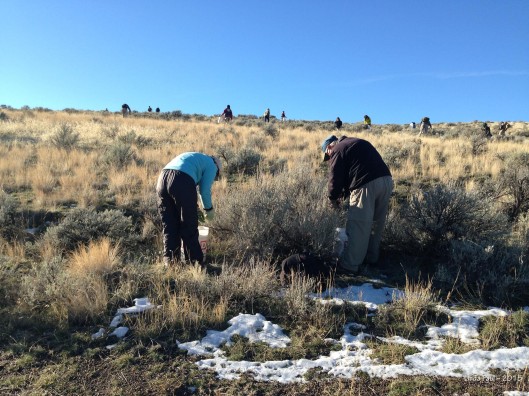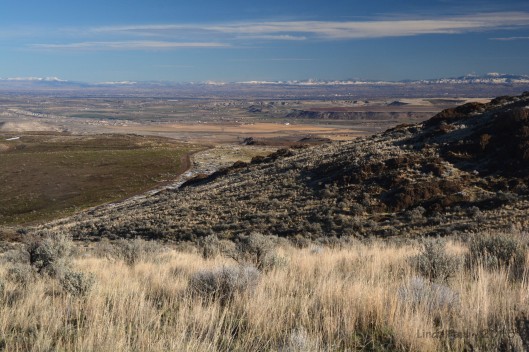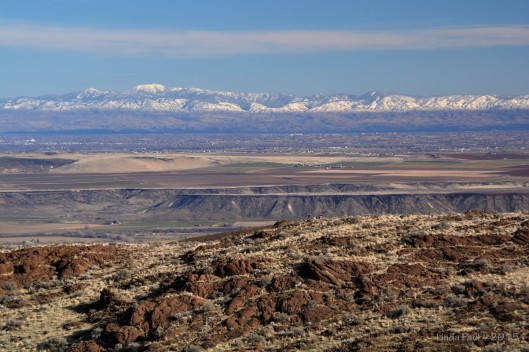Tags
Idaho, native seed collection Idaho Fish & Game, Owyhees, photography, sage grouse, sagebrush, Soda Fire
The chattery arrk-arrk of curious crows penetrates my zen state. I look up to marvel at the bottomless blue sky sheltering the noisy birds. After a week of frigid and wet weather, this blue sky Saturday is a benediction. About 75 volunteers, organized and managed by the Idaho Fish and Game, dot the sagebrush knolls, buckets attached to their belts or rimming their resting buttocks as they crouch over sagebrush plants to strip precious seeds that will be used to restore sage habitat destroyed by the 2015 summer Soda Fire.
After the 45 minute bus ride to the parking lot, we grab buckets and gloves and march to this little oasis that escaped the fire and gather around Fish and Game officer, Michael Young, for instructions on how to harvest seed from the fertile plants.


As we disperse and flit from bush to bush like bees in search of pollen, I chuckle at the memory of my mother’s passion for sagebrush. My own feelings about the plant are less rosy. It’s damned hard to walk or ride through and the smell evokes car sick memories of sage branches mother set to bake on the dashboard of our old Chrysler as she bumped over dirt roads and careened around blind curves when I was a kid. She’d have been in hog heaven here.
The process of seed stripping is evocative of milking a cow, minus the grumpy sidekick. After a few hours of seed stripping, it is difficult to walk past a ripe seed stalk without reaching out for those seeds, much like after a day of weeding, having to resist the urge to pull the weed under your neighbor’s barbecue.

These are the precious seeds we are after

Holding the base of the stem in one hand, the other milks the seeds off the stem and into the bucket

The stem in the center has been stripped. To it’s left is a stem waiting to share its bounty.
Past attempts at sagebrush restoration have been disappointing. But ongoing research into the complexity of the sage steppe ecosystem brings new insight to the process. It turns out that there are hundreds of varieties of sagebrush, each tailored for very specific soil and climate conditions. As little as a 5 degree difference in winter soil temperature can spell doom for misplaced seedlings.
Three subspecies are most common to the burned area.
- Wyoming Big Sagebrush
- Basin Big Sagebrush
- Mountain Big Sagebrush
Within those subspecies specific genetic variations make it possible for sage to thrive in various micro-climates. Our mission is to collect seeds from the Wyoming Big Sage, however we passed some Basin Big Sage plants in the gorge as hiked to our gathering spot. One of the biologists shows us how to distinguish the two by their leaves. But I couldn’t say I got that. I just try to stay away from the really tall bushes in the gorge.


Looking out over a patch of cheat grass to the patchwork of scorched earth
By mid afternoon, the scattered bucket brigade begins to filter back to the parking lot where we dump our contributions into bags. A field estimate gauges that we collected about 25 pounds of raw material. This will be taken to the USDA Forest Service Lucky Peak Nursery where it will be cleaned, sorted, and dried. The resulting two pounds of viable seed will be hand distributed in the early spring.

I photographed those snow-covered hills after they were blackened last summer.
This seed collection project is just one of many ongoing attempts to disrupt the rampant growth of cheat grass, enemy of American open range, and to restore the Owyhee range habitat so that it can support Sage Grouse, wild horses, and all the abundant diversity that needs to thrive in that ecosystem.

The Owyhee topography is varied and rugged.

Looking out over the Snake River canyon to Boise and the mountains beyond. Wouldn’t you know it, after I had committed to this Saturday project, Bogus Basin opened new terrain with fresh powder. I looked longingly toward where all my buddies were slicing and dicing the powder. Sigh.
And now my coat and backpack are sage-scented air fresheners for the coat closet.
,

Linda, well done. I love your description of seed stripping. Keith
LikeLike
Must be you’ve encountered a milk-heavy bovine or two, Keith!
LikeLike
Linda, my wife is the one who grew up on the farm. Her Aunt Mary could milk a cow like nobody’s business. My wife said she was too gentle and Aunt Mary would fuss at her. Have a great week, Keith
LikeLike
That’s funny, Keith. My stepfather had a milk cow. I was curious about the milking end of things, but when I tried, I could barely get a drop at a time. I suspect I was being too delicate about it too, because I have strong hands. But I never tried too hard because I recognized that if I learned how, I’d get stuck with the chore.
LikeLike
What a wonderful post, Linda! Thanks so much for sharing the experience and super pics with us. The smell of sage always make me think of poultry, and this time of year … Christmas turkey! 🙂
LikeLike
Thanks, Doreen. It’s funny, I like the smell of the culinary sage herb. But sage brush is so oily potent, that it’s just a bit too much for me. But this was a fun project anyway. 😉
LikeLike
Loved reading this, Linda. I would have been right there next to you if I lived there. I like wild sage, it reminds me of yoga studios. When we were out west a couple of years ago I picked some to make a sage stick that I burn every so often at home (want to make it last). Not sure I was supposed to pick it, after reading your post, but promise not to do that again.
LikeLike
Hah. I don’t think it’s a protected species yet. There’s plenty of it around…just not always where it needs to be. The real evil player is that darned cheat grass that grows so quickly and dries out quickly making tremendous fuel for wildfires. My closet does smell good. 😉
LikeLiked by 1 person
Wonderful writing and pictures Linda! I hope all the efforts of you and the other good folks are successful this year.
LikeLike
Thanks, Denise. I hope so, too.
LikeLike
I love your writing and especially about your mom! I think this is an interesting project! The pictures are just gorgeous and what scenery this area has! Love this post so full of many things, memories, information and amazing photos!! Thanks a great read!
LikeLike
Gee thanks. It’s funny. Other people see so much more in my writing than I do. I’m glad because mostly I think I’m pretty shallow. Thanks for the encouragement.
LikeLiked by 1 person
haha no it is pretty entertaining and I loved everything, even your sage brush jacket in the closet! 🙂
LikeLiked by 1 person
What an amazing, meaningful morning. Good for you. Sorry you missed a skiing trip. Your photos capture the day beautifully.
LikeLike
Thanks, Sybil. I wish you could have been there with me. I think you’d have really enjoyed it.
LikeLike
Sounds like a perfect day, doing something good for the environment in the company of like-minded people. Exercise like this beats lifting weights at the gym any day!
LikeLike
Thanks for dropping by Mary and for sharing your thoughts. It was a great day. I did a similar project the following Saturday when the weather was much colder and the location was not as remote and cool. But, the seeds on those bushes were far more productive. In just a few hours I had my bucket full right to the top.
LikeLike
Pingback: Seven stallions for seven mares__and freedom! | Rangewriter